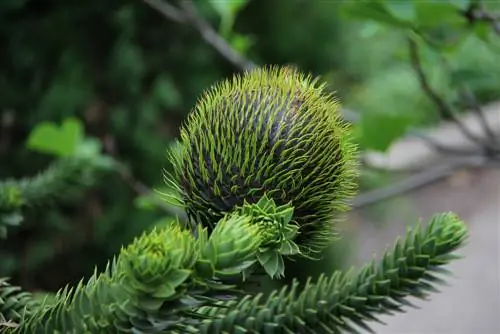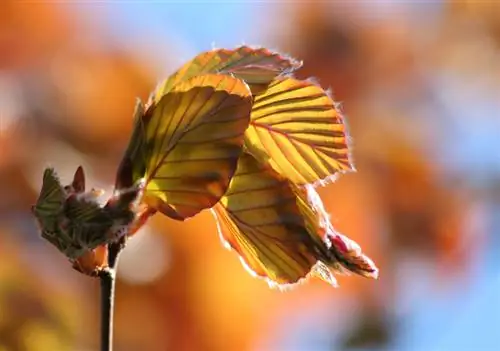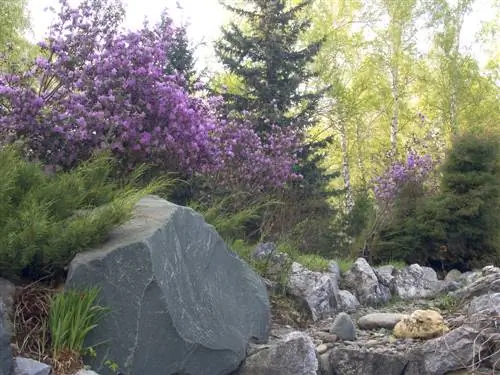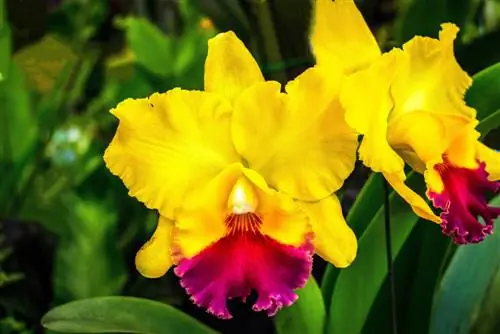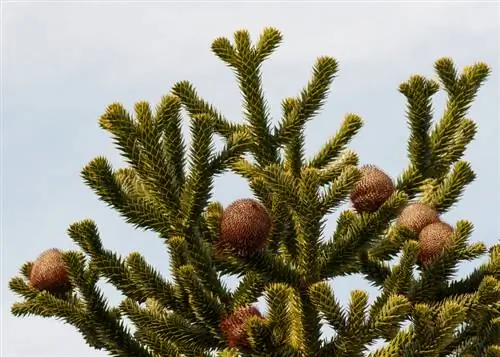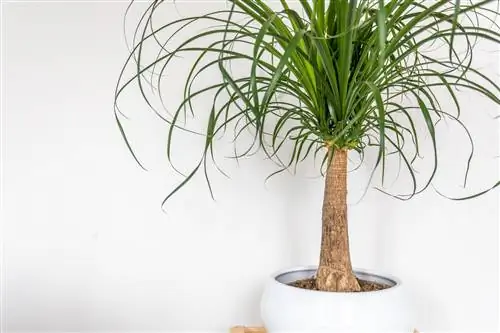- Author admin [email protected].
- Public 2023-12-16 16:46.
- Last modified 2025-01-23 11:21.
More than any other conifer in this country, the araucaria attracts everyone's attention with its eye-catching, prickly, scaly needle structure and offers an exotic variety in every front garden design. Read below to find out how best to cultivate the southern hemisphere ornamental fir.
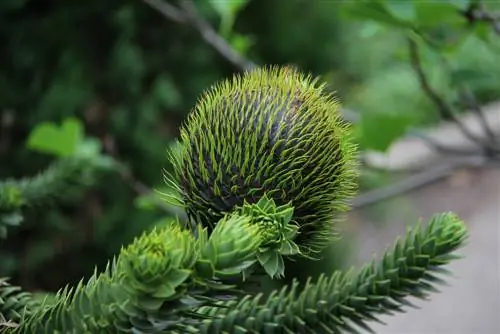
What conditions do araucarias need for optimal growth?
Araucarias are exotic conifers that occur in various areas of the southern hemisphere. In Central Europe they are mainly cultivated as garden or house plants, with Araucaria araucana (Chilean araucaria) and Araucaria heterophylla (household fir) being particularly popular. What is important for them to thrive are uniform, bright locations, humus-rich, well-drained soils and regular watering with low-lime water.
Origin
The biological systematics of the Araucaria genus says a lot about their areas of origin. It is divided into 4 different sections, which include a total of 19 species. The reason for this division is simple: their original area of origin is affected by strong disjunction, i.e. by the division of the area by geological influences.
The various araucaria species can therefore be found in large parts of the southern hemisphere: both in South America from Chile, Argentina and Paraguay to Brazil, as well as on the islands east of Australia such as New Caledonia, the Norfolk Islands and New Guinea as well as in eastern Australian Queensland to New South Wales.
The areas that they inhabit in these countries are climatically very different habitats from tropical, moist rainforest areas to cool altitudes of up to 2400 meters. Depending on the section and species, the araucarias prefer different location requirements.
In our case, however, some of them can also be cultivated outdoors without any problems, which will particularly please those garden owners who like to add special structural accents to their private oasis.
Origin in keywords:
- Araucaria come from different parts of the southern hemisphere
- Populate different climate zones in South America, eastern Australia and the islands east of Australia
- In this country, some species can be easily cultivated outdoors
Growth
The special growth with an almost cylindrical overall silhouette and mostly prickly, thick needle leaves is certainly what is particularly attractive about the araucaria from our Central European perspective. The evergreen tree extends its long, somewhat serpentine, circular and horizontal branches from the trunk. Due to the even, non-branched needling of the branches and their slightly twisted shape, the araucaria also has the nickname “snake fir”.
In their native areas, araucarias can reach impressive heights of up to almost 90 meters. Females generally grow larger than males. In addition, the trees can get extremely old: the highest recorded age of a particular specimen is an impressive 1000 years.
In our case, however, an araucaria grows to a maximum of 5 meters tall and up to 4 meters wide.
Growth characteristics at a glance:
- Striking, cylindrical overall contour and mostly exotic, prickly needle foliage
- circular, tiered, serpentine branches
- In the native areas up to almost 90 m high and up to 1000 years old
- In this country a maximum of 5 m high and 4 m wide
leaves
The needle foliage of the araucaria is very exotic and striking to the Central European eye, especially that of the Chilean araucaria. Its individual leaves have a triangular, tapered shape and a thick consistency. This gives the branches an almost cactus-like style. Instinctively you want to avoid touching it as much as possible - and in fact the tips of the leaves can sting painfully.
The leaves are spiral-shaped, whorled and dense, arranged in a scale-like staggered manner around the branches - at least in the older stages. The leaves on the younger shoots are even softer and needle-shaped, and are also significantly brighter green than the mature specimens. Like the tree itself, the leaves last for a very long time, usually for many years.
Leaf properties in brief:
- Triangular, tapered shape
- Strongly stinging
- Young leaves still soft, needle-shaped and light green, older ones thick, scaly overlapping and darker
- Reaching old age
Flowers
Araucarias bloom in late summer, usually in July to August. However, it can take around 30 years for an araucaria to bloom for the first time.
Fruit
Araucaria are usually dioecious, i.e. they have separate sexes. So there are male and female individuals. The main difference between the female and male cones is their shape: while females are almost spherical and stand upright, the males have an elongated, cylindrical shape. The cones are located individually or in groups at the ends of the shoots and have a weighty consistency due to the abundant milky juice they contain. The winged seeds, which are up to 4 cm long, are edible in some species. They contain plenty of proteins and oils.
To remember:
- The separate sexed araucaria form different cones
- Male cones elongated-cylindrical, female cones spherical and upright
- Heavy consistency, contains a lot of milky juice
- Seeds of some species edible, with high protein and oil content
Which location is suitable?
If you want to cultivate an araucaria outdoors, this is usually not a problem. However, depending on your area of origin, you should pay attention to a location with as much light as possible. However, too much sun is not really good for some species. Most of the species cultivated in this country prefer uniform light. This also promotes balanced, straight growth. Depending on the species, you will of course also have to allow enough space for growth in height and width.
Good protection from harsh winds is also relatively important. If possible, place the araucaria as close to the wall of the house as possible, where sharp gusts of wind from the same direction do not regularly whistle around the corner.
The araucaria species Araucaria heterophylla also has the nickname carpenter fir - so it is particularly suitable for cultivation in the home. You should place an indoor fir in a bright, open space, ideally in a winter garden, loosely surrounded by other plants. The indoor fir also welcomes pleasant living temperatures of 18 to 20°C. In summer it can also be placed outside in a protected place. It should spend the winter a little cooler, at around 5 to 10°C.
Location conditions at a glance:
- In open field cultivation as bright as possible, even from all sides, full sun but not necessarily recommended
- Protect as much as possible from strong winds
- Provide enough space
- In room culture: Evenly bright (winter garden) at living temperature, can be taken out in summer, kept a little cooler in winter
What soil does the plant need?
Araucarias thrive best in a slightly acidic soil environment with a relatively high humus content and a loose consistency. Uniform humidity and rather warm temperatures are good. When cultivating outdoors, you should loosen up heavy soils in particular with a good proportion of sand.
If you want to keep your araucaria in a pot, place it in a substrate made of relatively nutrient-rich, humus-rich and slightly acidic soil; special rhododendron soil from the garden center is well suited. Loosen the substrate with plenty of sand and, if necessary, expanded clay to ensure effective drainage.
To remember:
- Araucaria needs nutrient-rich, humus-rich soil
- Good permeability and uniform moisture
- ph value in a rather acidic range
- Loose up heavy garden soils with lots of sand
- For container cultivation, rhododendron soil with a good amount of sand
Watering Araucaria
Regular watering is essential for araucarias. The leafy conifers require a consistent, even water supply, so active watering is also necessary when grown outdoors, especially during long, hot dry phases in summer. However, waterlogging must not occur - so make sure that you incorporate an effective drainage layer into the ground when planting and that the upper layer of soil is always dry before each watering.
When growing in containers, watering in slightly smaller increments is necessary because of the less voluminous planting substrate. Water the araucaria during the main vegetation phase depending on the evaporation behavior of the pot ball - it should always be moist, but under no circumstances should water remain in the saucer. When waterlogged, the araucaria quickly loses its needles, so you can at least avoid root rot in good time.
Similar to some large-leaved houseplants from the tropics, occasional showers from the water disperser are also good for the araucaria. For watering and spraying, use water with as little lime as possible, if available, from the rain barrel.
Casting practice in brief:
- Araucaria must be watered carefully and very evenly, especially during longer dry periods in summer
- But definitely avoid waterlogging
- Additional spraying with water disperser is recommended, especially when growing in containers
- Use as little limescale (rain) water as possible
Fertilize Araucaria properly
Araucaria doesn't actually need to be fertilized outdoors. Unless the planting soil is particularly poor. Then when planting you should first improve the soil with lots of organic long-term fertilizer in the form of leaf compost. Once the araucaria is established in its location, you can also give it some additional universal liquid fertilizer or compost during the growth phases.
In the bucket, additional fertilization can definitely make sense. Here too, keep an interval of around 2-3 weeks between fertilizer applications.
Cut Araucaria correctly
Incision care is not absolutely necessary for araucaria. Their growth is naturally so clean that even strict aesthetes should have little objection to it. In addition, the araucaria is not particularly willing to sprout new growth if it is trimmed too haphazardly. If shoots that are too long are bothersome, you can also shorten them a little. However, make sure that the branches arranged in a circle around the trunk remain approximately the same length so as not to disturb the overall silhouette.
If you really want to take pruning measures, you should wait for a dry, mild phase in summer.
To remember:
- Pruning care hardly necessary and not recommended
- Short shoots that are too disruptive, paying attention to uniformity with regard to the overall silhouette
- Carry out pruning measures in summer when the weather is mild and dry
Wintering
If you don't live in an excessively cold area, you don't actually have to worry about overwintering an araucaria planted outdoors. Most variants are sufficiently frost hardy for the Central European winter. However, some varieties are a little more sensitive than others and young, newly planted specimens should also be protected as a precaution in winter. To do this, it is usually sufficient to cover the ground around the planting area with fir branches or garden fleece.
If temperatures remain below -15°C for a long period of time, unsightly cold damage can occur as the tree can no longer draw liquid from the permanently frozen ground.
An araucaria kept indoors should be kept a little cooler over the winter than in the summer, at around 5-10°C. Well-suited locations include a window seat in an unheated stairwell or, even better, a cold house.
You should water an araucaria in the pot a little more sparingly during the winter and stop fertilizing altogether.
To remember:
- Usually unproblematic overwintering outdoors
- For certain, more sensitive varieties and young specimens, precautionary cold protection with fir branches or garden fleece makes sense
- Severe permanent frost can lead to cold damage
- When growing indoors, overwinter the pot in a cool place at 5-10°C
- Economical watering, no fertilizing
read more
Propagate Araucaria
Araucarias are best propagated through seeds. You can win these from the ripe cones of your own specimen or purchase them from specialist retailers.
The seeds generally show good germination. However, if possible, you should not store them over the winter, otherwise they risk drying out completely. It is best to plant them in planting trays with growing substrate (€6.00 on Amazon) or directly in the ground outdoors immediately after harvesting. However, they only germinate there after about 4 months and are not quite as successful under the harsher conditions.
You have a slightly higher chance of germination if you sow the seeds indoors and let them germinate carefully with regular humidity and at an ambient temperature of around 20-22°C. Of course, this requires a lot of patience and attention. Creating a protected microclimate under glass or foil can definitely make sense. You can transplant germinated young plants into pots or cold frames in spring.
Varieties
Special cultivars are not common among araucarias, but the species do differ from one another. The Chilean araucaria (Araucaria araucana) and the carpenter fir (Araucaria heterophylla) are particularly popular in this country for garden and indoor cultivation.
Araucaria araucana
The Chilean araucaria or Andean fir is characterized by the typically serpentine, circular and tiered branches with thick-spined needles and has experienced an economic upswing in our latitudes in recent years. It is particularly suitable for planting in the garden, as it requires a lot of space with its height of around 5 m and up to 4 m width. It also makes an impressive picture in front of the house.
It needs a light but relatively wind-protected location in loose, humus-rich soil and regular water supply.
Araucaria heterophylla
The indoor fir is, unsurprisingly, best suited for indoor cultivation. Its appearance is slightly different and much gentler than that of the Chilean Araucaria due to the softer, less prickly needles. The indoor fir doesn't grow as tall as its counterpart: in its natural habitat it can reach around 65 m, but in this country when cultivated indoors its growth is limited at the latest by the ceiling.
The indoor fir should be kept at a moderate living temperature and with relatively high humidity and should be placed in a humus-rich, loose substrate.

